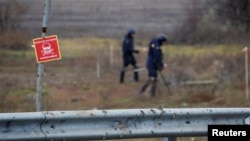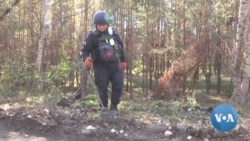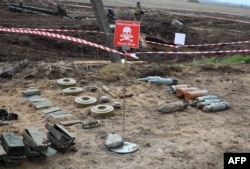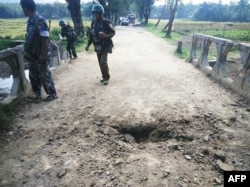Russia and Myanmar are the only two countries to have used antipersonnel mines this year, according to the latest annual report from the International Campaign to Ban Landmines (ICBL). Neither country is among the 164 states that are party to the 1997 Mine Ban Treaty.
The ICBL is a global coalition of nongovernmental organizations chaired by Human Rights Watch. It won the Nobel Peace Prize in 1997. The Landmine Monitor 2022 report is being presented this week at the Mine Ban Treaty's annual meeting at the United Nations in Geneva.
Ukraine
The report says at least 277 people have been killed or maimed by antipersonnel landmines in Ukraine this year.
Russian forces have mined vast areas since their February invasion. Visiting demining teams — working in the recently liberated areas around Kherson on November 16 — unearthed explosive devices. Ukraine's Deputy Interior Minister Meri Akopyan outlined the scale of the problem.
"We understand that Ukraine is the most contaminated country in the world. At this moment, we have more than 200,000 square kilometers not checked yet and not demined. This is just about liberated territories. We still have a lot of occupied territories which we don't count in right now," Akopyan told reporters.
Russia has deployed mines by hand, dropped from aircraft, and via artillery and rocket fire, according to Mary Wareham, arms advocacy director at Human Rights Watch and an editor of Landmine Monitor 2022.
"Russian forces have used at least seven types of antipersonnel landmines since the Russian invasion of Ukraine on the 24th of February. There's also some evidence that improvised victim-activated explosive devices have been used. And those fall under the prohibition of the international treaty banning landmines," Wareham told VOA.
Russia has not responded to the report. Moscow does not deny using antipersonnel mines.
Myanmar
Myanmar's military has consistently used antipersonnel mines since the first Landmine Monitor report was published 24 years ago.
"There was some increased use of antipersonnel mines by government forces in Myanmar around telecom towers, pipelines and other energy installations, as well as some use by non-state armed groups in that country," Wareham added.
The Landmine Monitor 2022 report says antipersonnel mines are still in the ground in at least 60 countries. Globally, there were more than 5,500 new victims of landmines or explosive remnants during 2021, including over 2,000 deaths. Where the age was recorded, half of those killed or maimed were children.
Syria
Syria recorded the highest toll with over 1,200 casualties. In Afghanistan, there were more than 1,000 new landmine victims.
The report says that non-state armed groups have recently used antipersonnel mines in the Central African Republic, Colombia, the Democratic Republic of Congo and India, as well as in Myanmar. These mainly consist of improvised explosive devices.
Landmines continue to pose a hazard in Yemen, including in areas where fighting between Houthi rebels and government forces has ceased. Ahmed Al-Marouai lost his son Mourad in January. The nine-year-old stepped on a landmine as he combed the beach for rubbish to sell, close to the Yemeni city of Hodeidah.
"I wrapped pieces of his body in a blanket and carried it all to the Criminal Investigation Department. I did not wash him or put him in a [burial] shroud ... I just buried pieces of him in a plastic bag," Al-Marouai told Agence France-Presse.
Mine Ban Treaty
The 1997 Mine Ban Treaty bans antipersonnel mines and requires countries to destroy stockpiles, clear mine-affected areas and assist victims. The report says 94 states have destroyed a total of more than 55 million landmines from their stockpiles since the agreement came into effect.
The United States is not party to the treaty. However, President Joe Biden announced in June that it was the administration's goal to ultimately join. He also committed to limiting the use of antipersonnel mines in most places around the world.
In a statement at the time, the White House said landmines have a "disproportionate impact on civilians, including children, long after fighting has stopped."












